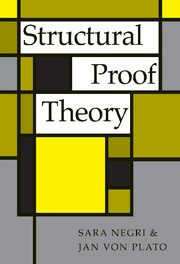Book contents
- Frontmatter
- Contents
- PREFACE
- INTRODUCTION
- 1 FROM NATURAL DEDUCTION TO SEQUENT CALCULUS
- 2 SEQUENT CALCULUS FOR INTUITIONISTIC LOGIC
- 3 SEQUENT CALCULUS FOR INTUITIONISTIC LOGIC
- 4 THE QUANTIFIERS
- 5 VARIANTS OF SEQUENT CALCULI
- 6 STRUCTURAL PROOF ANALYSIS OF AXIOMATIC THEORIES
- 7 INTERMEDIATE LOGICAL SYSTEMS
- 8 BACK TO NATURAL DEDUCTION
- CONCLUSION: DIVERSITY AND UNITY IN STRUCTURAL PROOF THEORY
- APPENDIX A SIMPLE TYPE THEORY AND CATEGORIAL GRAMMAR
- APPENDIX B PROOF THEORY AND CONSTRUCTIVE TYPE THEORY
- APPENDIX C PESCA – A PROOF EDITOR FOR SEQUENT CALCULUS (by Aarne Ranta)
- BIBLIOGRAPHY
- AUTHOR INDEX
- SUBJECT INDEX
- INDEX OF LOGICAL SYSTEMS
1 - FROM NATURAL DEDUCTION TO SEQUENT CALCULUS
Published online by Cambridge University Press: 25 February 2010
- Frontmatter
- Contents
- PREFACE
- INTRODUCTION
- 1 FROM NATURAL DEDUCTION TO SEQUENT CALCULUS
- 2 SEQUENT CALCULUS FOR INTUITIONISTIC LOGIC
- 3 SEQUENT CALCULUS FOR INTUITIONISTIC LOGIC
- 4 THE QUANTIFIERS
- 5 VARIANTS OF SEQUENT CALCULI
- 6 STRUCTURAL PROOF ANALYSIS OF AXIOMATIC THEORIES
- 7 INTERMEDIATE LOGICAL SYSTEMS
- 8 BACK TO NATURAL DEDUCTION
- CONCLUSION: DIVERSITY AND UNITY IN STRUCTURAL PROOF THEORY
- APPENDIX A SIMPLE TYPE THEORY AND CATEGORIAL GRAMMAR
- APPENDIX B PROOF THEORY AND CONSTRUCTIVE TYPE THEORY
- APPENDIX C PESCA – A PROOF EDITOR FOR SEQUENT CALCULUS (by Aarne Ranta)
- BIBLIOGRAPHY
- AUTHOR INDEX
- SUBJECT INDEX
- INDEX OF LOGICAL SYSTEMS
Summary
We first discuss logical languages and rules of inference in general. Then the rules of natural deduction are presented, with introduction rules motivated by meaning explanations and elimination rules determined by an inversion principle. A way is found from the rules of natural deduction to those of sequent calculus. In the last section, we discuss some of the main characteristics of structural proof analysis in sequent calculus.
LOGICAL SYSTEMS
A logical system consists of a formal language and a system of axioms and rules for making logical inferences.
(a) Logical languages: A logical language is usually defined through a set of inductive clauses for well-formed formulas. The idea is that expressions of a formal language are special sequences of symbols from a given alphabet, as generated by the inductive definition. An alternative way of defining formal languages is through categorial grammars. Such grammars are well-known for natural languages, and categorial grammars for formal languages are in use with programming languages, but not so often in logic.
Under the first approach, expressions of a logical language are formulas defined inductively by two clauses: 1. A statement of what the prime formulas are. These are formulas that contain no other formulas as parts. 2. A statement of what the compound formulas are. These are built from other simpler formulas by logical connectives, and their definition requires reference to arbitrary formulas and how these can be put together with the symbols for connectives to give new formulas.
- Type
- Chapter
- Information
- Structural Proof Theory , pp. 1 - 24Publisher: Cambridge University PressPrint publication year: 2001



